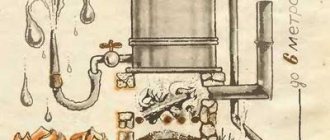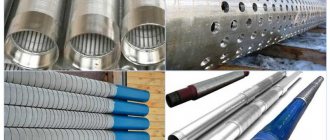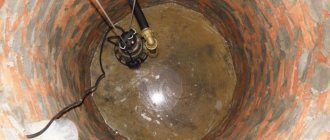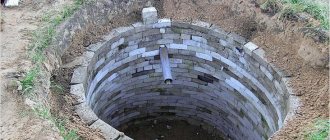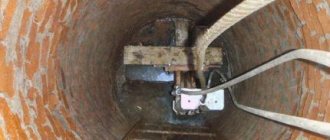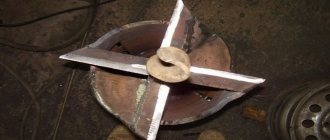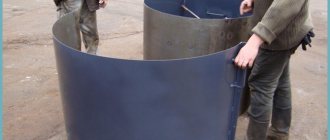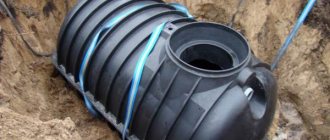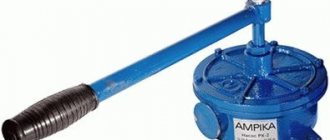Water at their summer cottage is required not only by the owners to comply with sanitary and hygienic standards. It is necessary for watering plants, caring for the territory and pets, refreshing and swimming in the hot summer. Agree that it is difficult to lift the entire required volume from the source manually with buckets.
However, there is a way to alleviate the difficult fate of summer residents - this is a homemade water pump. Even if you don’t have the funds to buy pumping equipment, you can become the happy owner of a useful technical device. To build it, sometimes literally just the power of thought is enough.
We have collected and systematized for you valuable information about making almost free homemade products. The models presented for consideration were tested in practice and deservedly received recognition from the owners. A thorough description of the manufacturing technology is supplemented with diagrams, photographs and video materials.
Design #2 – manual pump with direct spout
A very simple device for pumping water from a barrel or a shaft well. The advantages of this design: speed of assembly, low cost.
Required parts:
- PVC pipe d.50mm – 1 pc.;
- PVC coupling d.50mm – 1 piece;
- PPR pipe d.24mm – 1 pc.;
- PPR branch no. 24 – 1 piece;
- PVC plug d.50mm – 2 pcs.;
- piece of rubber, diameter 50mm, thickness 3-4mm – 1 piece;
- check valve 15mm – 1 piece;
- empty silicone bottle 330ml – 1 piece;
- tightening screw clamp – 1 piece;
- screw-nut or rivet – 1 piece;
- union nut no. 15 – 1 pc.
We begin the assembly of the entire structure with the manufacture of a check valve.
Construction of a check valve. We prepare a check valve from a Ø 50mm plug. We drill several holes around the perimeter of the plug Ø 5-6mm. In the center we drill a hole of suitable diameter for a screw-nut pair or rivet.
On the inside of the plug we place a rubber disk Ø 50mm. The disc should not rub against the walls of the plug, but should cover all drilled holes. We tighten it in the center with a screw-nut or rivet; a screw will not work. If difficulties arise with materials or manufacturing, you can replace it with a factory-ready check valve.
What a factory-made check valve used to operate a pumping station is is described in detail in the article we recommend.
Preparing the pump sleeve. The length of the sleeve should be commensurate with the depth of the well or container with water. We cut the PVC sewer pipe Ø 50mm to the required length, from the narrow end. We insert the newly made valve into the pipe socket. For reliability, we fasten it on both sides with self-tapping screws.
For the second end we prepare a plug with a pre-drilled hole Ø 25mm. This hole in the plug is made according to the diameter of the PPR pipe Ø 24. Great precision is not required, the plug serves as a sliding support.
Piston assembly procedure. Cut off the spout of an empty silicone container. Next, you need to heat the balloon and insert the sleeve into the PVC so that the diameter of the balloon exactly matches the diameter of the sleeve. Place the silicone can on the valve from the reverse side of the arrow (the arrow on the check valve shows the direction of water movement).
We cut off the excess balloon. We secure it with a union nut no. 15.
Pump rod design. The length of the rod should be 50-60 cm greater than the length of the sleeve. You need to heat one end of the rod and insert a check valve. The arrow on the check valve should point towards the inside of the stem. Until the pipe has completely cooled down, we tighten it with a screw clamp.
Final assembly of the pump. We insert the rod into the sleeve and attach a plug (sliding support) through the coupling on top. To top it off, we attach a 24mm PPR bend to the end of the rod pipe. All you have to do is connect the hose and you can pump water.
The pipe material can be any, and the cross-section is not necessarily round. It is important to select the appropriate piston for the liner
The outlet serves as a support for the hand. For convenience, you can take a tee and plug one side of it.
Homemade pump for overflowing water
The simplest mini-pump for overflowing or pumping water can be assembled in just 10 minutes. At the same time, you will not only not spend money on the manufacture of this device, but will also solve such an important problem as recycling household waste. This water pump, which is essentially a check valve to which a tube with an outlet is connected, will be especially useful in cases where you have to frequently draw water from a large container into buckets.
So, to make a simple water pump with your own hands, you will need the following consumables:
- several necks cut off from plastic bottles with caps screwed onto them;
- a piece of hose of the required length;
- tube that will serve as a rod.
A suitable check valve can be used to pump water using this method.
A homemade water pump is made from the above materials according to the following algorithm.
- It is necessary to remove a thin gasket from the cork of a plastic bottle and cut it in a circle, reducing its diameter by about 2 mm and leaving a 3 mm wide segment intact.
- A hole with a diameter of 8–10 mm is drilled in the center of the plug itself, through which the pumped water will flow into the rod tube.
- The gasket is inserted into the cork, into which the neck cut off from the bottle is screwed. Thus, the neck screwed into the cork will press only the untouched segment of the gasket, leaving the rest of it movable.
- A rod tube is connected to the resulting valve, which will act as a nipple.
- To increase the water capture surface, a “skirt” is put on the stem with the valve, also made from a bottle cut to the required length.
- They complete the manufacture of a mini water pump with their own hands by connecting a piece of hose to the back side of the rod-tube.
To activate the water pump, you need to immerse its intake part in a container of water and, holding the rod, make several reciprocating movements. As a result, the liquid medium from the container will begin to flow into the hose by gravity if there is a level difference. To stop the process of overflowing water from the container, it is necessary to raise the end of the hose above the level of the valve or simply remove such a valve from the aquatic environment.
Design #3 – manual pump with side spout
The previous design has one, but significant drawback. The spout moves with the stem. This design is not much more complicated, but much more convenient.
The sleeve needs to be improved. Add a 50mm PVC tee to the design with a 35 degree bend. The tee must be inserted into the upper part of the sleeve. In the rod, near the piston, we drill several large-diameter holes, the main thing is not to overdo it and not to disturb the rigidity of the entire structure.
The piston moving upward pushes the liquid into the outlet pipe. The top cover serves as a support for the piston rod
Now water will begin to pour into the space between the rod and the sleeve. When the piston moves upward, water will begin to flow into the spout.
Mechanisms for self-construction of wells
Usually, special drilling equipment is used to construct a well, so a completely logical question arises: how to drill a well in a country house without using it? It turns out that there is a simple manual mechanism consisting of a drilling rig and a column suspended from it. Let's take a closer look at the individual pieces of equipment.
The base is a tower resembling a tripod. The material for the supports is either metal pipes or logs connected at the top with a pin. The drill column lifting block is also located there. The two legs of the tower are connected by a winch (gate).
The design of drilling equipment may vary. In some cases, if the impermeable layer lies close to the surface of the earth, a hand drill is sufficient
The drilling column is the main functional element. It consists of several three-meter rods connected by couplings. Sometimes a length of one and a half meters is enough. It is the column that is immersed in the ground, and its length is adjusted using rods. Replacement of special equipment are water pipes equipped with steel couplings.
Drilling heads must be selected depending on the nature of the soil. Here are the most commonly used: 1 - “spoon”, 2 - “snake”, 3 - “chisel”, 4 - “bailer”
The impact or soil-cutting element is the drill head. It is screwed onto the column using a threaded adapter. As the head is lowered into the soil, soil fills the drill cavities. For different types of rocks, different attachments are used: a “spoon” is suitable for soft soil, a “coil” for dense soil, and a “chisel” for hard rocks. Use a bailer to lift the loosened soil up.
To prevent the walls of the well from crumbling, casing pipes are used - as a rule, these are ordinary plastic plumbing products, lightweight and easy to install. The bottom of the pipe is a kind of shoe, with a smooth or jagged edge at the bottom.
There are two main types of casing shoes: a – toothed (mill), b – smooth. Cutting area: 1 – teeth, 2 – smooth edge
Thus, the construction of a well takes place using special equipment, some of which can be purchased at the store, some of which you can make yourself.
Design #4 – piston well pump
This pump design is suitable for wells no more than 8 meters. The operating principle is based on the vacuum created by the piston inside the cylinder. A useful homemade product can be an excellent alternative to factory-made pumping equipment and will help solve the problems of water extraction for servicing a summer cottage.
In such pumps, the top cover is either absent or has a slot-like hole, since the rod is rigidly connected to the handle
Necessary materials:
- metal pipe, diameter 100mm, length 1m;
- rubber;
- piston;
- two valves.
The performance of the pump directly depends on the tightness of the entire structure.
You will find a detailed description of the manufacturing process of a piston pump for use in a summer cottage in one of the popular articles on our website.
Step #1: Assembly of the unit sleeve
To make a pump sleeve, you need to pay attention to the inner surface; it must be even and smooth. A good option would be a liner from a truck engine.
From below, a steel bottom needs to be welded to the sleeve along the diameter of the well head. Either a reed valve or a factory valve is installed in the center of the bottom.
A cover is made for the top of the sleeve, although this part is more aesthetic, you can do without it. It is necessary to pay attention to the fact that the hole for the piston rod is made slot-like.
Step #2: Construction of the Pump Piston
For the piston you need to take 2 metal disks. Between them lay not very thick rubber 1 cm, slightly larger in diameter than the disks. Next, we tighten the disks with bolts.
As a result, the rubber disk will be clamped and a sandwich of metal and rubber should be obtained. The idea is to create a rubber rim along the edge of the piston, which will form the necessary piston-liner seal.
All that remains is to install the valve and weld the eye for the stem.
Step #3. Making a petal valve from rubber
The reed valve consists of a rubber disc of not very thick thickness. The disc size should be larger than the inlet holes. A hole is drilled in the center of the rubber. Through this hole and a pressure washer, the rubber disk is secured over the inlet holes.
When sucked, the edges of the rubber rise and water begins to flow. During the reverse stroke, clamping pressure is created: the rubber reliably blocks the inlet holes.
Step #4: Final Assembly and Installation
It is advisable to cut a thread at the head of the well and at the bottom of the pump sleeve. The thread will allow the pump to be easily removed for maintenance and will make the installation sealed.
We install the top cover and attach the handle to the rod. For comfortable work, the end of the handle can be wrapped with electrical tape or rope, laying turn to turn.
If the pump does not pump water, it is necessary to eliminate all leaks, including in connection with the well head (+)
The limitation on the depth of the well is due to the theoretical impossibility of creating a vacuum of more than 1 atmosphere. If the well is deeper, you will have to modify the pump to a deep pump.
Advantages and types of hand pumps
The speed of pumping water mechanically and the resulting volume are significantly inferior to electrical analogues, however, the technique has a right to exist, as it has its advantages. The main advantage is autonomy, which minimizes risks. It is appropriate to use the technique if any condition exists:
- relatively low need for daily water volume;
- for a homemade shallow well or a well located on your own personal plot;
- a hand pump for pumping out water is used as an emergency source in case of a power outage at the main water intake device;
- for public use when there is no desire to use a traditional chain, crankshaft and bucket;
- if there is no electricity connection at the site.
In some cases, a mechanical piston unit in working form is used as a decorative element, complementing the created exotic surroundings of the site.
Such a unit can also become a decoration for the site.
Separately, the sites require fecal pumping units, which are used for pumping contaminated media, including for cleaning sewer pits, cellars and lower floors during flooding. The design includes a grinder designed for a certain particle size, which crushes foreign impurities during operation.
Operating the device has its advantages:
- quick installation;
- repairable units;
- low maintenance;
- unified components;
- long uninterrupted service life;
- minimum cost of the finished product.
The disadvantage in some situations is the need to apply physical force to pump. This makes the device inconvenient for use by elderly, weak people and children. The result will also be low productivity.
Design #5 – deep-well piston pump
The difference from a conventional piston pump is that the pump sleeve must be installed at the depth of the well. In this case, the length of the rod is more than 10 meters.
The sleeve of such a pump can serve as a wellbore, and the role of a spring can be played by a suspended load (+)
There are two ways to solve this problem:
- Make the rod from a lighter material, for example, aluminum pipe.
- Make a rod from a chain.
The second option requires some explanation. In this case, the rod is not rigid. The bottom of the liner is connected to the bottom of the piston by a return spring.
Choosing a household drain pump
Which drainage pump should I choose for pumping out dirty water?
- Issue: №5 (218) May 2017
- Text: Boris Bezel
In a suburban area, there are often situations when it is necessary to pump out water that has accumulated in the wrong place at the wrong time. It is not always possible to get rid of water manually; for this it is better to use special pumps.
Perhaps, any dacha farm needs such a “do-it-all” pump - to pump out water from barrels, pits, drainage ditches, from construction sites and in other similar situations. For such work, special drainage models are usually used, but in some cases universal garden pumps are also suitable.
When is a drain pump needed?
What is the difference between a drainage pump and other types of models? Firstly, a feature of their design is the ability to pump water, figuratively speaking, from a puddle. Drainage pumps have a squat, pedestal-shaped body. They take in water through holes located at its base. A depth of only 2–3 cm is enough for this technique to work properly, and some models of drainage pumps are capable of pumping water even from puddles several millimeters deep! A very useful feature that is necessary if water needs to be removed from a flat surface as thoroughly as possible. This could be pumping water from a basement or a children's pool - in cases where it is not possible to specifically bury the pump in a pit to collect water (this will be discussed below). In addition, drainage pumps are designed not only for clean, but also for slightly contaminated water. After all, “street” water always contains soil, sand and other debris. It is advisable that the pump be protected from their influence.
The simplest protection option is a grill on the hole through which water is drawn in. Professional equipment uses pumps with a working mechanism made of durable, wear-resistant material. Such models are expensive (tens of thousands of rubles), and it makes sense to purchase them only for constant work in difficult conditions, for example, for pumping water from a construction pit. Household drainage pumps costing several thousand rubles are not designed for such a serious load. These are usually centrifugal pumps with a plastic impeller. If a large pebble gets into such a wheel, it will most likely cause a part of one of the blades to chip, and the performance will decrease. After several hits, the wheel will need to be changed. When purchasing, ask in advance where this can be done and at what price, since many owners of such pumps experience damage to the plastic impeller.
The drainage pump is not designed to lift water to a great height (that is, create pressure), unlike, say, well pumps buried deep underground. For him, 5–10 m of pressure is quite enough. But many drainage pumps are characterized by high productivity, which can be 10–15 m3/h or more. High productivity is especially necessary where there is a large volume of water. Imagine you want to pump out a pond
10 m and a depth of 1 m. A pump with a capacity of 10 m/h will cope with pumping out such a volume in about half a day. And the submersible vibration pump “Malysh” with a productivity of 0.5 m3/h cannot be controlled even in a week.
Choosing a household drain pump
Choosing a household drainage pump Which drainage pump should you choose for pumping out dirty water? Issue: No. 5 (218) May 2021 Text: Boris Bezel In a suburban area there are often situations
Design #6 – American or spiral type
The spiral pump uses the energy of the river flow. To operate, the minimum requirements must be met: depth - at least 30 cm, flow speed - at least 1.5 m/s.
Option 1
Necessary materials:
- flexible hose d.50mm;
- several clamps according to the diameter of the hose;
- intake – PVC pipe 150mm;
- wheel;
- pipe reducer.
The main difficulty in such a pump is the pipe reducer. This can be found in decommissioned sewer trucks or obtained from factory equipment.
For greater efficiency, an impeller is attached to the pump
The flexible hose is attached to the wheel in a spiral using clamps. An intake made of PVC pipe 150mm is connected to one end. The second end of the hose is put on the pipe reducer.
Water is taken in by the water intake and moves in a spiral, creating the necessary pressure in the system. The lifting height depends on the flow speed and the immersion depth of the intake.
Option 2
Necessary materials:
- flexible hose d.12mm (5);
- plastic barrel d.50cm, length 90cm (7);
- polystyrene foam (4);
- impeller (3);
- sleeve coupling (2);
We cut an intake hole in the bottom of the barrel. Inside the barrel, it is necessary to lay the hose tightly in a spiral and connect it to the sleeve coupling.
Inside the barrel, the hose is laid tightly, pressed against the walls with a strip. The barrel can be metal with foam floats
To impart buoyancy, foam floats must be glued inside the barrel. Finally, screw on the impeller.
For this design option, the drain hose must be 25 mm. in diameter.
Manufacturing of Scroll Hydraulic Pump
For a dacha or a private house, in the immediate vicinity of which a river flows, you can make your own water pump, which looks very similar to a carousel (you can see the principle of its operation in a video on the Internet). The basis of the design of such a pump is a wheel with blades, driven into rotation by a moving river flow. The pumping unit in this device is a spiral made of a plastic pipe with a diameter of 50–75 mm and fixed to a wheel with blades using clamps.
Spiral hydraulic pump
The pipe spiral branch pipe, located on the outer contour of this design, is equipped with an intake bucket, which is made from a pipe of a larger diameter - 150 mm. The internal pipe of the spiral design is connected to a pipe reducer, which is located at the level of the axis of the wheel with blades and is securely fixed to a fixed base.
Pipe reducer is a key component of a volute pump
The maximum height to which such a homemade water pump can lift the pumped liquid medium will depend on the distance covered by the intake bucket of this device under water. The principle of operation of the water pump in question is based on the fact that at the moment the intake bucket is immersed in water, a closed system is formed in the spiral pipeline, consisting of sections of the liquid medium and air cavities, as a result of which the pumped liquid medium moves to the center of the spiral and enters the pipe reducer.
The cost of such a pumping installation, the manufacture of which will require certain knowledge and skills, will depend on how much the consumables and technical devices used in its design will cost you.
With the help of such original pumping equipment, you can organize complete watering of a summer cottage or personal plot in the summer, without using an electric pump for these purposes. This will save energy.
Design #7 – wave energy pump
As the name suggests, such pumps use wave energy. Of course, the waves on the lakes are not that big, but the pump works around the clock and is capable of pumping up to 20 cubic meters per day.
Option 1
Necessary materials:
- float;
- corrugated pipe;
- two valves;
- mounting mast.
The float is a pipe, a log, selected depending on the rigidity of the corrugated pipe, experimentally.
Corrugated pipe can be made of plastic or metal. The weight of the log must be selected experimentally
Two valves operating in the same direction are mounted in a corrugated pipe.
As the float moves downwards, the corrugated pipe stretches, resulting in water intake. When the float moves up, the corrugation contracts and pushes the water up. Therefore, the float must be quite heavy and large.
The entire structure is rigidly attached to the mast.
Option 2
This design differs from the first option in that the corrugated pipe is replaced by a brake chamber. This diaphragm-based scheme is very often used in simple DIY water pumps. Such a pump is quite versatile and can receive energy from wind, water, steam, and sun.
The brake chamber should be disassembled and only two holes left for the valves.
Instead of homemade valves, you can use ready-made plumbing valves. The washers must be of sufficient diameter so that the diaphragm does not tear (+)
Manufacturing suitable valves is a separate task.
Necessary materials:
- copper or brass tube;
- balls of slightly larger diameter - 2 pcs.;
- spring;
- copper strip or rod;
- rubber.
For the inlet valve, cut off the tube and drill it out so that the ball sits tightly on the tube. It is necessary to ensure that the ball does not allow water to pass through. To prevent the ball from falling out, solder a wire or strip on top.
The design of the exhaust valve differs from the intake valve in the presence of a spring. The spring must be installed between the ball and the copper strip.
We cut out a diaphragm from rubber to the size of the brake chamber. To drive the diaphragm, you need to drill a hole in the center and stretch the pin. We insert the valves from the bottom of the brake chamber. For sealing, you can use epoxy glue.
It is better to find non-metal balls for valves, so they will not be subject to corrosion.
Option 3
Based on the design of the two previous options, you can think about building a more advanced model.
It is advisable to choose a log that is dry and not resinous, so it will be lighter, pay attention to the absence of cracks
For this pump it is necessary to drive four stakes (1) into the bottom of the reservoir. Then make a float from a log. You need to make cuts in the log so that it does not rotate when swinging on the waves.
For durability, it is recommended to treat the log with a hot mixture of kerosene and drying oil. It must be done carefully, processed in a water bath: there should be no open flame.
The log travel limiters (3) and (4) are nailed in such a way that the log does not damage the pump rod (5) during maximum movement.
Wave pump
This design operates using wave energy and is capable of pumping water from a nearby body of water.
The main working part of the pump is a hollow cylinder in the form of an accordion. By contracting and stretching, the accordion changes its internal volume. One end of the corrugated pipe is connected to a log in the water, and the other to a holder on a pile that is driven into the bottom. On both sides the accordion has valves installed in bushings. When waves hit, the log begins to rise and fall, thereby transmitting oscillatory movements to the corrugation, compressing and decompressing it. If you pour water into it, the valves will start working and the pump will pump water.
If a corrugated pipe with a diameter of 50-60 mm is used, then the log should weigh 60-80 kg. To prevent the log from breaking the lift when high waves occur, a limiter should be attached to the pile. A bolt is passed through it and secured in the log. The head of the bolt should be under the cover plate, so that the log will rotate freely in different directions and will not break the pile if an unwanted torque occurs.
Important! If you have problems finding a corrugated pipe, then there is a wave pump design that works without it. Instead of corrugations, rubber ring diaphragms are used, connected in series into a single package.
Annular diaphragms are tightened with metal rings along the edges, inside and outside. The inner rings are made of metal and holes are made in them. A cord is attached between the rings, which will limit excessive stretching of the pump. Valves are also installed at the top and bottom of the pump.
As the log moves upward, the membrane package stretches, the bottom valve opens, and the pump begins to fill with water. As the log descends, the bag contracts, the bottom valve closes, and the top valve opens. Water is squeezed out through it.
Design #8 – device from a washing machine
Often, parts or even entire units from old things remain on the farm. You can remove a centrifugal pump from a washing machine that is no longer needed. This pump is perfect for pumping water from a depth of up to 2 meters.
Necessary materials:
- centrifugal pump from a washing machine;
- petal valve from a washing machine or homemade one;
- plug, bottle stopper;
- hose;
- preferably an isolation transformer.
If you use a ready-made valve from a washing machine, it needs to be modified. One hole needs to be plugged, for example using a bottle cap.
Excess pump holes must be plugged. If the case is metal, grounding is required
We connect the petal valve to the hose and lower it into a pit or well. Connect the second end of the hose to the pump. For the system to start working, it is necessary to fill the hose with the valve and the pump itself with water. All that remains is to connect the transformer, and the pump is ready for use.
Diaphragm pump
A diaphragm pump is made at home from a brake chamber from a truck, for example, from a MAZ-200.
A diaphragm pump is manufactured as follows.
- The camera is disassembled and all holes on the base (1) are sealed. The bolt holes do not need to be sealed.
- Holes for the inlet and outlet valves are drilled at the bottom of the base.
- The membrane (4) is made from a car inner tube and is secured using a brass rod with two brass washers. The diaphragm is glued around the perimeter to the body and additionally pressed with bolts.
- The pump is assembled according to the drawing above.
Design #9 – water pump from compressor
If you have already drilled a well and have an air compressor, do not rush to purchase a water pump. It will be successfully replaced by a structurally simple airlift device.
Necessary materials:
- spout pipe 20-30mm;
- air pipe 10-20mm;
The operating principle of the pump is very simple. It is necessary to drill a hole in the spout pipe and place them closer to the bottom. The hole should be 2-2.5 times larger in diameter than the air pipe. All that remains is to insert the air pipe and apply air pressure.
One of the most efficient and simple pumps, does not clog and can be assembled in 5 minutes
The efficiency of such a pump depends on the height of the water level, the depth of the reservoir, and the compressor power (performance). The efficiency is about 70%.
Tools and parts for G. Sokolov's pump
For the Grigory Sokolovka pump, you need to take 2 plastic pipes for plumbing 50 cm long with a diameter of 40 mm and 32 mm, two plugs for them, a coupling with a diameter of 40 mm, a 45 degree corner with a Ø 32 mm and a 90 degree corner also with a diameter of 32 mm. Additional sealing is done with a special rubber bushing. The valves are made of a sheet of rubber or other waterproof material 1–2 mm thick. The preparation of plastic elements is done with metal scissors. Additionally, you need to prepare a piece of twine, silicone grease and a lighter. The plug is glued with a heat gun or any waterproof glue.
Design #10 – gear water machine
The heart of this design is gear pumps for pumping oil from agricultural or truck equipment. The power steering power plant from KrAZ has similar characteristics.
Unit characteristics:
- pump working volume – 32 cm3;
- maximum pressure – 2.1 Atm;
- operating speed – 2400 rpm;
- maximum permissible rotation speed – 3600 rpm;
- nominal pumped volume – 72 l/min.
If possible, a motor from a washing machine is connected to such a pump. The motor of household appliances has a number of advantages: it runs on a single-phase 220V network and has a starting system (capacitor).
Gear mechanisms can be left- or right-handed, you need to pay attention to the direction of the arrow on the body
Pulleys and a belt may be required to obtain the required RPM. The advantage of a gear pump is that the gears are able to create the necessary suction force even without first filling it with water.
The only note: after operating the pump, to prevent corrosion of the steel gears, it is necessary to let the pump run idle for about 20 minutes.
Types of hydraulic pumps
Manufacturers offer several types of devices for collecting water from aquifers:
Piston hand pump
Traditionally, this particular device is found in the areas. It effectively copes with the task of collecting liquid from shallow depths of up to 7-8 m. It is based on a working piston moving along a cylinder.
It is installed 1 m above ground level. Due to the mechanical control of the lever, the manual pump pump drives the piston. When moving in one direction, liquid is taken into the cavity; when moving in the opposite direction, a portion of water is sent upward. This is how pumping occurs.
Rod hand pump
A hand pump for water is used in areas for sampling from lower horizons of 7-30 m. The principle is similar to the operation of a piston pump, but the length of the “piston” (plunger) is much longer and resembles a drill rod.
Due to its significant dimensions, the plunger apparatus creates a vacuum at a low depth and supplies liquid upward through the inlet pipe.
Gate (rotary-plate)
It has low power and is often used for pumping liquids from barrels or open reservoirs. Outwardly they resemble a tube, at the end of which a pump with a rotor is mounted. It has high mobility unlike other varieties.
If necessary, it can be used in various operations, since it is light in weight, and a regular hose is used for sampling.
Membrane
The device is capable of pumping out even contaminated liquid. The design uses self-cleaning ball valves. This solution allows us to minimize the possibility of jamming of the mechanism. A special feature of such models is the absence of quickly wearing or rubbing parts. The body is made of cast gray cast iron.
When choosing a specific instance, you need to pay attention to the following models:
Hand pump for water at the dacha BSK
It is used without modernization at a horizon not lower than 6 m. When installing an additional check valve, it is capable of sampling from a 9-meter level. Aesthetic appearance allows you to decorate any area. For fastening, the structure has a flange that allows you to fix the device on a pipe or platform. Possibility of installation to a vertical surface is provided. The estimated cost is 4800 rubles.
Hand pump for water at the dacha D-40
D40, Membrane (diaphragm)
Membrane type device. Capable of self-cleaning from possible contamination. Effectively copes with pumping liquids of any type. The cost is 6300 rubles.
Hand pump for water at the dacha RNP 1.3/30
Used in liquid media, including contaminated liquid. Capable of passing contaminants up to 1 mm in diameter. The maximum maximum concentration of pollution should not exceed 30 g/m3. Operates at a horizon of up to 5 m. The body is made of cast iron. The stroke type is double-sided, which increases the performance of the device. The cost is 16,200 rubles.
Hand pump for water at the dacha “K” (impeller)
Used for depths up to 9 m. The design includes 4 valves and a wing. Working with the handle, the operator alternately opens and closes the valves through which the liquid is supplied. The cost of the product in a steel case is 3,100 rubles.
A manual pump for pumping should be in any household. This small alternative device will successfully replace the pumping station in the event of an unauthorized power outage. It will also be useful in case of failure of pumping equipment. This will make it possible to pump up the volume, albeit in a limited quantity, but not be left without it at all.
Design #11 – pump from a bicycle wheel
Productive pump based on two wheels.
Necessary materials:
- PVC sewer pipes and outlets;
- bicycle wheel;
- nylon rope;
- small pulley;
- several pistons;
- mounting rod.
The operating principle of this pump is similar to that of a dragline.
First you need to build a sleeve from a sewer pipe that will be immersed in water. A drain is placed on the top of the sleeve through which water will flow. Next, install a small pulley on the bottom (a wheel rim from a wheelbarrow will do) and a bicycle wheel on top.
We attach a series of pistons along the entire length of the rope, first passing them through the sleeve. The rope should go around the pulley and the bicycle wheel.
The device is very effective, especially if you use a bicycle drive. It will be much easier to twist your legs.
By rotating the bicycle wheel, each piston on the rope captures water and, like an elevator, lifts it upward. The water column pours into the outlet.
For work you will need
- PVC sewer pipe 50 mm with bends, plug and sealing cuffs 1 m long;
- Check valve 1/2″ - 2 pcs.;
- Polypropylene sewer pipe with a diameter of 24 mm;
- Rubber, bolt/nut pairs with washers with a diameter of 8 mm;
- Clamps, fitting clamps and bends;
- Other plumbing parts subject to availability of spare parts.
There are two ways to drain the water.
Method 1: drain through the handle
A homemade water pump of this kind is very durable and reliable, but it is not entirely convenient, because the center of the water outlet is quite mobile.
Attention: This pump model is also one of the most affordable and unpretentious. The operating principle is as follows: water rises along the piston rod, which is made of a polypropylene pipe, and pours out from above.
So:
- First you need to make a base for the sleeve: cut a pipe 650 mm long and 50 mm in diameter. Then you need to drill 10 holes with a diameter of 5 mm in the plug and cut out a round piece of rubber 4 mm with a diameter of 50 mm. Next, you should secure the flap in the center of the plug to the bolt. You should know that self-tapping screws are completely unsuitable for this. The end reed valve is ready. After this, install the plug into the pipe on the sealant through the seals, while additionally fixing it with self-tapping screws through the pipe wall.
- The check valve must be installed in a 700 mm polypropylene pipe. To do this, you need to insert a fitting with a valve into the heated end of the pipe, which allows water to flow in the direction of the pipe. The connection must be strengthened with a worm clamp, but this must be done before it cools down.
- From the nose of the tube you can make a piston head. In order for the head to take the appropriate shape and size, it must be placed in the sleeve, but preheated, which is very important. After this, it must be trimmed and sequentially installed on the check valve using a coupling with an external thread or an “American” union nut. After this, insert the piston into the sleeve and make the top plug. A 90° bend must be installed at the free end of the pipe.
Method 2: side drain
A homemade water pump has its positive qualities. One of the important advantages is the very low price of the finished structure.
Attention: It is in some ways similar to the first option, but with the exception of one thing: large holes must be made in the piston rod pipe, but without compromising the structural rigidity.
So:
- You can also use a rod rod. A 35° elbow tee must be included in the sleeve. After this, water will be able to flow into the sleeve and, with the same reverse force, rise to the spout point.
- Another pump option is the spiral hydraulic piston. This device is made on the basis of a carousel with blades, in some ways it is similar to the wheel of a water mill. It is important to note that the carousel is powered by river flow. Therefore, this option is not suitable for everyone, because the river is the activator.
- In this case, the pump will be a spiral made of a flexible pipe with a diameter of 70 mm, secured to the wheel with clamps. A bucket made of a larger diameter pipe is attached to it in the intake part.
- The pipe reducer will be the main unit through which water enters the pipeline. It can be obtained from a sewage pump or factory equipment. The gearbox is located in the wheel along its axis and is firmly attached to the base, which is motionless.
- The maximum height of water rise is equal to the length of the pipe from the fence, which must be completely immersed in water during operation. In other words, this is the distance from the point of immersion to the point of water exit that the water intake bucket travels.
- At the moment of immersion, a closed system with several sections of air appears in the pipeline. The water follows the pipe to the center of the spiral.
- The final pump option is the compressor pump. This type of pump is very convenient and does not require costs if the farm already has a compressor intended for other purposes. The cost of the pump itself is very low.
- The first pipe will serve to supply water. Its diameter should be 30 mm. The second pipe is necessary to supply air from the compressor. Next, you should make a hole in the first pipe from the edge of 50 mm and insert a second pipe of a smaller diameter. This is done in order to create a hydraulic system in a larger diameter pipe. This node is immersed in water. The free end of the first pipe is fed to the water collection point, in other words, to the storage tank.
- The pump efficiency (efficiency) directly depends on the compressor power, delivery height and immersion depth. Due to the design features, it cannot exceed 70%. The efficiency is equal to the depth of immersion, which is divided by the sum of the height of the entire path of water and the depth of immersion. The acceptable compressor power can only be determined experimentally.
In principle, homemade water pumps are in no way inferior to industrial ones. Here, its production alone will cost much less. And the repairs won't be expensive. There are instructions and now you can decide on the option. Look at the photo, weigh everything and make a decision.
Design #12 – “homemade” for a small stream
This pump can operate on an ultra-low amount of energy. Of course it’s good if there is a river or lake. But what to do if the river becomes very shallow in the summer? A swing type pump will help.
Such a pump allows you to use very small amounts of energy from a small stream.
The main part of the structure is two buckets rigidly connected to each other through blocks (4). It is necessary to make a drainage system from the stream from galvanized steel (3). In order to reduce wear, a piece of plastic is placed under it. The drainage system is rigidly connected by a leash to a rope (5).
Leash 6 is made of rigid wire and the length is calculated so that the drainage system moves to the desired angle
The entire system must be adjusted so that when one bucket is filled, the drainage moves to the second bucket. The energy of the buckets is transmitted through the crank (8) to the pump (10).
water pump
The classic pump scheme, which has been used for several decades in many villages and towns without running water.
The following components will be needed:
- PVC pipe 5 cm in diameter with plug and elbows.
- Check valves 0.5 2 pieces.
- PPR pipe 2.4 cm in diameter.
- Rubber gaskets and several pairs of bolts with a 6-8 mm nut.
- Additional details.
Let's make a pump.
In order for the structure to work, it is necessary to ensure the reliability and tightness of the structure. The handle is connected to a piston, which creates pressure in the working chamber. Under the influence of increased pressure, water passes through two valves and reaches the outlet. If you do not ensure the reliability of the housing and the tightness of the gasket, your efforts will be in vain
Design #13 – Shukhov wick pump
The Russian inventor Shukhov became famous for many buildings, including the radio tower in Moscow. Below we will discuss another of his inventions - a water pump.
Pulleys are made composite. The depth of the groove should be slightly less than the swollen rope
The pump uses a special rope to operate. This rope consists of woven cotton threads with a total thickness of 5-6 mm, enclosed in a sheath. The thread is passed through the pulleys.
When movement occurs, the rope gets wet and wraps around the pulleys. The pulley (5) with the help of a spring (4) presses the rope against the pulley (3) with force. The squeezed water flows into the tray (7). Figure “c” shows sections of pulleys (3) and (5), respectively.
To operate the entire system, an electric motor of only 5-10 watts is required. Typically, such engines have 1500 rpm.
To reduce speed and increase force, you can use a worm gear, shown in figure “c”. It is quite possible to make it by hand. To do this, you need to find a suitable gear and make a worm from wire. Small forces on the shaft allow manufacturing inaccuracies.
With your own hands you can assemble not only a pump that pumps water for domestic needs, but also a device that can be successfully used in landscaping a site. The following article will present successful options for homemade fountain pumps.
What to look for when choosing
If there is an urgent need for a hand pump, then you should know how to correctly choose the optimal model.
- First of all, the parameters of the well (depth of the aquifer) and the parameters of the pumps offered for sale are compared. As already mentioned, most hand-held models are capable of working with sources located on the forehead at least 6 ÷ 8, rarely 10 meters. If the burial is deeper, then there is no alternative: you will have to install only a sucker rod pump.
- It is important to know the performance of the pump - how much water it is capable of pumping per cycle (or per unit of time - a minute, under intense load))
- The next parameter of the planned (or existing) well - the diameter of the casing pipe, also affects the choice of pump. If the pipe has a nominal bore of 4 inches (100 mm) or more, there are no problems, and you can purchase any pump. But in the case when the casing is narrower, the rod pump may no longer be suitable - it will simply be impossible to lower its working pump assembly into the water column.
- It is necessary to know the degree of contamination of the water from the well - usually the pump's specifications indicate the permissible level with which the equipment is capable of operating.
- It would probably be worthwhile to evaluate the ease of working with the pump. It is necessary to keep in mind that among the users there may be people of advanced age or children - will their efforts be enough to collect at least a small volume of water.
- It is necessary to think about how the pump will be installed - what mounting platforms or mounting holes, brackets or lugs, etc., are available for a particular model. It is also important to know the weight of the purchased device in order to foresee possible ways of installing it in advance - whether it will be a metal welded frame, a concreted platform, a flange connection to a casing pipe coming out of the ground, a wall mount, or just some lightweight option for seasonal use.
- Based on the expected operating conditions, you can determine the design features of the product. So, for installation only in the summer, you can purchase a lightweight plastic version. If a permanent installation is intended, then the choice is made in favor of cast iron or stainless steel. In addition, for temporary use you should purchase a model that is easy to quickly install and dismantle on your own.
- Finally, for many owners, the determining factor is also the external decorativeness of the pump - this has already been mentioned in the article. Of course, purchasing a pump that can decorate a site will entail much more serious financial costs.
The value of the pressure created by the pump is very often not assessed - such devices, as a rule, are not designed for pumping water through external pipelines. Water from them is most often collected into placed containers.
Features of operation of surface pumps
Surface pumps, as the name implies, are installed on the surface. These are relatively inexpensive and quite reliable devices, although they are not suitable for very deep wells.
It is rare to find a surface pump that can supply water from a depth of more than 10 meters. And this is only with an ejector; without it, the performance is even lower.
Surface pumping stations have a wide range of applications; they pump water from various sources with a depth of no more than 10 m
If your dacha has a well or a well of suitable depth, you can safely choose a surface pump for the site.
You can take a model with a relatively low productivity for irrigation or a more powerful device that will effectively provide water to a private home. The convenience of surface pumps is obvious: first of all, it is easy access for adjustment, maintenance and repair.
In addition, the installation of such a pump at first glance looks very simple. The pump must be installed in a suitable location, lower the hose into the water, and then connect the device to the power supply. If the pump is needed only for irrigation, you can purchase and install it without any additional elements.
To optimize the operation of the device, it is recommended to take care of an automated control device. Such systems can turn off the pump if a dangerous situation arises, for example, if water does not flow into it.
“Dry running” is not recommended for almost all models of surface pumps. You can also automate the pump shutdown if the watering time has expired, the required volume has been filled, etc.
How to make a mini pump yourself
Sometimes craftsmen want to make a mini water pump themselves. One of such devices may be the one proposed below. To work you will need:
- Electric motor.
- Ballpoint pen.
- Super glue, better quick-drying and waterproof.
- Deodorant cap.
- A small gear, about the same diameter as a cap.
- Four plastic pieces measuring 10 x 10 mm.
Work instructions:
- All the teeth of the gear are ground off, which is then adjusted to the size of the cap.
- Plastic pieces are glued with glue at 90 degrees opposite each other.
- To form the pump body, the walls of the cap are cut off, leaving them 1.5 centimeters high.
- Holes are drilled on the top of the body to fix the motor axis and on the right to fix the handle body.
- The ballpoint pen is disassembled, leaving only the body, and glued in the cap to the side hole.
- The motor is glued to the upper hole of the housing.
- The impeller is attached to the motor axis.
- A plastic panel is cut out, the diameter of which is the same as the cap.
- A hole is drilled in the panel for water intake and it is hermetically glued to the body.
What mini-pumps you can make yourself, how they work can be clearly seen from the video in this article.
The idea was born to make a mini fountain myself. The design of the fountain itself is a separate story, but this article will talk about how to make a pump for circulating water with your own hands. This topic is not new and has been described on the Internet more than once. I am just showing my implementation of this design. If anyone is too lazy to do it, then such pumps are sold on Aliexpress for around 400 rubles (price as of February 2016).
So let's get started. A bottle of nasal drops was used as a body. For those who are interested, I will write down the dimensions of some parts. So, the inner diameter of the bubble is 26.6 mm, depth 20 mm. A hole slightly larger than the diameter of the motor shaft is drilled in it on the back side, and a hole on the side for water outlet (4 mm in diameter). A tube is attached to it first with superglue and then with hot glue, through which the water will subsequently rise to the top of the fountain. Its diameter is 5 mm.
We also need a front cover. I drilled a 7 mm hole in the center. The entire body is ready.
A hole for the shaft is drilled in the base. The diameter of the base, you understand, should be smaller than the diameter of the body. I have about 25 mm. In fact, it is not needed at all and is used only for strength. The blades themselves can be seen in the photo. Made from the same box and cut to the diameter of the base. I glued everything together with superglue.
The engine will rotate the impeller. It was most likely taken out of some kind of toy. I don’t know its parameters, so I didn’t raise the voltage above 5 V. The main thing is that the engine is “faster”.
I tried another with a speed of 2500 rpm, so it raised the water column very low. Next you need to assemble everything and seal it well.
And now the tests. With a power supply of 3 V, the current consumption is 0.3 A in load mode (that is, immersed in water), at 5 V - 0.5 A. The height of the rise of the water column at 3 V is 45 cm (rounded down). In this mode, I left it in the water for an hour.
Passed the test fine. How long it will last is a good question that only time can answer. When powered by 5 volts, the water rises to a height of 80 cm. All this can be seen in the video.
A summer cottage and the presence of a well on it is a joy for every nature lover. Especially if electricity is supplied to the village and it is possible to pump water for irrigation from a well using a powerful unit.
But what to do if there is no electricity at all or it has been temporarily turned off?! Of course, you can simply carry water to the beds with buckets, but this is both tedious and simply time-consuming. Especially if the garden lands have a large area.
We bring to your attention a solution to the dilemma - assembling a water pump with your own hands. And believe me, such a water machine will work, although a little slower than an electric pump, but still quite productive. Let's look at several options for hand-assembled pumps.
Is it worth thinking about the fact that producing your own pump at home is not profitable and will lead nowhere? We are ready to prove the opposite to you, citing several advantages of such work:
- Firstly, the summer resident will always have a device at hand to supply water from the well to the top, even if the electricity is turned off.
- An important point is saving the family budget. So, electricity tariffs are growing by leaps and bounds, and a powerful pump in working condition generates a lot of kW. Such pump operation cycles, even for the purpose of watering the beds for a month, can result in a tidy sum for the average family.
